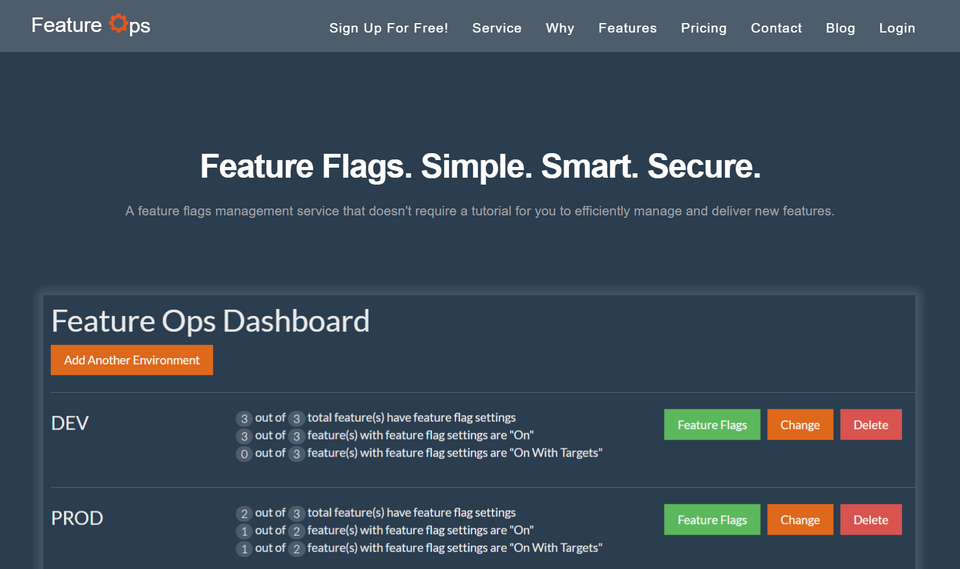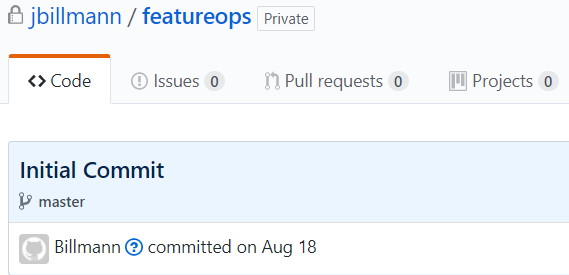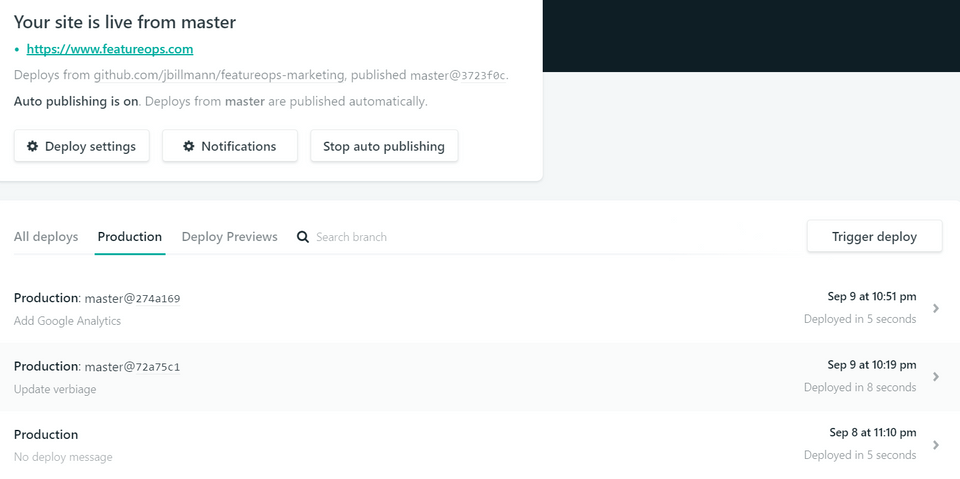How I Bootstrapped, Developed, and Launched a Startup in 21 Days and under $100
— startup, bootstrap, feature flags, feature toggles, feature ops, feature flags service — 6 min read
Recently I launched Feature Ops, a feature flags (toggles) management service and API, and while you, as a reader, might not necessarily be interested in the service itself, I think you'll find the 21 day journey from nothing to something a tad bit interesting.

Of course, it all starts with an idea.
I have had many ideas over the years, but before committing to an idea this time around I decided on a set of criteria. First off, the end application had to solve an established problem and, secondly, I had to be able to conceivably build the end service, in its entirety, without any outside assistance... in a reasonable amount of time. The latter being especially important because of my day job which, of course, limits my development time to nights and weekends.
It goes without saying that I did not have intentions of launching 21 days after starting or keeping the initial capital to under $100, but that's how it worked out, and so it makes for great SEO. So... I'll take it! ;-)
Here is my 21 day journey (and beyond).
August 18th (Days 1 - 16)
It's all about the development.

Without an application, nothing else mattered.
My entire focal point during the first couple weeks was to get things done from an application standpoint. Everyday, I re-prioritized the remaining features and set goals each night. I had read Rework 7 years ago and it left a lasting impression on me. Specifically, I wanted to keep things stupid simple, I wanted to "underdo the competition" in a good way. Each time I wanted to add a new feature, I would wage a mental chess game in my head to determine if I truly needed said feature. More often than not, the feature was cut.
Technically speaking, I decided that whatever development toolset I would leverage, had to be free (as in beer) and could mostly be done on a Windows PC or Mac. Cosmos DB is an outlier here and, in choosing, I effectively committed to Azure hosting early on.
I decided on the following technology stack:
React: free and open-source
JavaScript view library
Redux: free and open-source JavaScript state management library
Bootstrap: free and open-source responsive styling library
ASP.NET Core: free and open-source web framework
Cosmos DB: NoSQL database
Visual Studio Code: free and open-source IDE
I also had to send emails and take payments, so I opted to integrate with the following technology services:
Stripe: 2.9% + 30 cents per transaction
SendGrid: 100 emails/day free forever
I actually bought the domain during this phase. Ordinarly, I would recommend waiting, but my idea somewhat came to me in the form of a domain. It happened to be available and I thought it was too good to let it slide.
Namecheap Domain: $10.87
Money spent thus far: $10.87
September 4th (Days 17 - 20)
It's all about the marketing.
The greatest of ideas will fail without proper marketing.
I knew this was going to be a challenge for me as I am a software engineer by day (obviously not a marketing position). Here again, I wanted to keep things simple, so I opted for a single page marketing site. I thought about building my own, but I began weighing cost and time and I decided it was in my best interest to buy given the low price of themed templates.
Additionally, I wanted to integrate with some type of marketing platform (mailing list) and so I opted for MailChimp - free for up to 2,000 subscribers and 12,000 emails per month.
Finally, I knew I had to support email with regards to my custom domain. Here again, I wanted to keep things simple, so I decided to leverage email forwarding to my Gmail account. Gmail also gives you the ability to send emails on behalf of a custom domain.
I initially went with ImprovMX given that it is free and simple, but I found that its availability seemed to be inconsistent during my time with it. This was an absolute no-go. So, I instead switched to ForwardMX.
WrapBootstrap Theme: $16
ForwardMX: $9
Money spent thus far: $35.87
September 8th (Day 21)
It's all about the go-live.

Leading up to this day, I knew there were some things that had to be done ahead of time so I could launch without any potential legal blockers.
File LLC with the state: $50
Capital One Spark Business Bank Account: No fees or minimum balances
General Terms of Service & Privacy Policy: $5
When it came time for hosting, I had to weigh options for the Feature Ops marketing site as well as the application site.
I had narrowed my search for the Feature Ops marketing site to GitHub Pages and Netlify. I opted for the latter because SSL was a must and Netlify also offered simplistic and free integration with Let's Encrypt.
Netlify: Free for personal or commercial projects and free SSL
As for application hosting, I had sort of known all along that I would go with Azure. I have had very favorable things to say about my experience with Azure. (This blog is hosted on Azure with gives me an additional cost savings.) I also have a lot of great history with Azure when I worked with the Azure Team and the Ghost Team to get Ghost up and running in the Azure gallery.
Azure App Service: Basic - 1 Core - $55.80/month
Azure Comsos DB: 1 GB & 400 RUs - $24.06/month
Namecheap SSL: $9
Once I had launched, I spent hours upon hours of testing. This testing extended well beyond the first day. I knew that one misstep could cause unfavorable reviews and/or prevent users from actually using the system. I used Application Insights, which came along for the ride (for free) with my Azure hosting, to resolve any issues that arose with the application. This was the first time that I used Application Insights, but I will say that I was impressed with this offering. It made tracking down and fixing issues much easier than had I not had it.
Money spent thus far: $99.87
Days 21 + n
It's all about the SEO.
At this point, I had launched the product in 21 days and under $100. That's great and all, but let's get real, the toughest part is in the days and months ahead.
Knowing this, I have spent most of my recent time with Feature Ops attempting to improve SEO. I figure that Feature Ops will likely succeed or fail in the hands of Google.
(Therein lies the main reason for this blog post. ;-)
I added Feature Ops to Google Analytics, Google Search Console, and Bing Webmaster tools.
This also meant writing blogs when Introducing Feature Ops as well as posting on Hacker News, Reddit, Product Hunt, and LinkedIn just to name a few.
I also realized that I may have made an SEO mistake when I opted for a single page marketing site given its small footprint. So, I decided to tack on a company blog to Feature Ops. In this case, I opted for Hugo which played very well with my hosting on Netlify.
Days of Past and Future
It's all about the recurring costs.
You may have noticed that I did not include the recurring costs in the running tally. I did this because, up until this point, I have not actually paid for any recurring costs with the exception of GitHub that I have had for quite some time. These payments will be coming soon, but to recap:
Azure App Service: Basic - 1 Core - $55.80/month
Azure Comsos DB: 1 GB & 400 RUs - $24.06/month
GitHub: 1 Personal Account - $7/month
Netlify: Free for personal or commercial projects and free SSL
Stripe: 2.9% + 30 cents per transaction
SendGrid: 100 emails/day free forever
MailChimp - free for up to 2,000 subscribers and 12,000 emails per month.
(While I am pleased with my service with GitHub, I would recommend GitLab if you're looking to cut down on cost of having private repositories.)
Lastly, I recognize that as Feature Ops grows, my monthly recurring costs will likely change and additional decisions will have to be had. All things considered, that sounds like a great problem to have given that it means my user base will have grown.
Current monthly recurring costs: $86.86
In Summary
I found myself thinking about things I never thought I would have thought about when attempting to launch a startup.
Certainly cost and time was front and center during my work on Feature Ops, but they weren't necessarily a focal point or a driving reason behind why I decided to give it a try.
Looking back, I decided to write this blog post because, even though it took 21 days and $100 of initial capital, it also felt like a choose your own adventure book with many decision points along the way. Perhaps, all things considered, these decisions and what they amounted to might offer a decent amount of value for those who stumble upon this post...
And maybe, just maybe, it'll add some decent exposure and SEO to Feature Ops - a feature flags (toggles) management service and API.
